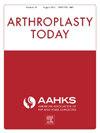Medial Deviation of a 6° Prosthetic Trochlear Groove After Kinematically Aligned Total Knee Arthroplasty Occurs in Four Types of Coronal Plane Alignment of the Knee (CPAK) and Decreases the Forgotten Joint Score
IF 1.5
Q3 ORTHOPEDICS
引用次数: 0
Abstract
Background
The study focused on kinematically aligned total knee arthroplasty (KA TKA). It identified which coronal plane alignment of the knee (CPAK) types are associated with a higher proportion of medial deviation of the 6° prosthetic trochlear groove (PTG) relative to the quadriceps’ line of pull and whether medial deviation adversely affected the Forgotten Joint Score (FJS). The research calculated the minimum PTG angle required to prevent medial deviation by at least 2° in all patients.
Methods
The study analyzed 296 KA TKAs with a postoperative long-leg scanogram and a 2-year FJS score. Radiographic measurements were used to determine the CPAK type and to identify the deviation of the 6° PTG relative to the quadriceps’ line of pull as medial (−) or lateral (+).
Results
Fifty-one percent of KA TKAs had a medial deviation of the PTG, and the proportion was higher in CPAK I, II, III, and VI than in IV and V types (P < .05). The median FJS of CPAK III was significantly lower than I and IV (P < .0262) and comparable to II, V, and VI (P > .085). The minimum PTG angle required to prevent medial deviation by at least 2° in all patients is 17°.
Conclusions
A medial deviation of the 6° PTG occurred in more than half of the KA TKAs and was observed in 4 of 6 CPAK types. Because medial deviation was associated with a lower FJS, it is suggested that the femoral component should have a minimum PTG of 17° to prevent medial deviation by at least 2° in all patients.
Level of evidence
IV.
四种类型的膝关节冠状面对齐(CPAK)发生6°假体滑车沟内侧偏移并降低遗忘关节评分。
背景:本研究的重点是运动学对齐全膝关节置换术(KA TKA)。该研究确定了哪种膝关节冠状面对齐(CPAK)类型与相对于股四头肌牵拉线的6°假体滑车沟(PTG)内侧偏度比例较高相关,以及内侧偏度是否对遗忘关节评分(FJS)产生不利影响。该研究计算了所有患者防止内侧偏移至少2°所需的最小PTG角度。方法:对296例KA tka患者进行术后长腿扫描和2年FJS评分分析。x线测量用于确定CPAK类型,并确定6°PTG相对于股四头肌牵拉线的偏差为内侧(-)或外侧(+)。结果:51%的KA tka患者存在PTG内偏,且CPAK I、II、III、VI型的比例高于IV、V型(P < 0.05)。CPAK III的中位FJS显著低于I和IV (P < 0.0262),与II、V和VI相当(P < 0.085)。在所有患者中,防止内侧偏离至少2°所需的最小PTG角度为17°。结论:6°PTG内侧偏位发生在超过一半的KA tka中,并且在6种CPAK类型中的4种中观察到。由于内偏与FJS较低有关,因此建议股骨假体的PTG最小应为17°,以防止所有患者的内偏至少为2°。证据等级:四级。
本文章由计算机程序翻译,如有差异,请以英文原文为准。
求助全文
约1分钟内获得全文
求助全文
来源期刊

Arthroplasty Today
Medicine-Surgery
CiteScore
2.90
自引率
0.00%
发文量
258
审稿时长
40 weeks
期刊介绍:
Arthroplasty Today is a companion journal to the Journal of Arthroplasty. The journal Arthroplasty Today brings together the clinical and scientific foundations for joint replacement of the hip and knee in an open-access, online format. Arthroplasty Today solicits manuscripts of the highest quality from all areas of scientific endeavor that relate to joint replacement or the treatment of its complications, including those dealing with patient outcomes, economic and policy issues, prosthetic design, biomechanics, biomaterials, and biologic response to arthroplasty. The journal focuses on case reports. It is the purpose of Arthroplasty Today to present material to practicing orthopaedic surgeons that will keep them abreast of developments in the field, prove useful in the care of patients, and aid in understanding the scientific foundation of this subspecialty area of joint replacement. The international members of the Editorial Board provide a worldwide perspective for the journal''s area of interest. Their participation ensures that each issue of Arthroplasty Today provides the reader with timely, peer-reviewed articles of the highest quality.
 求助内容:
求助内容: 应助结果提醒方式:
应助结果提醒方式:


